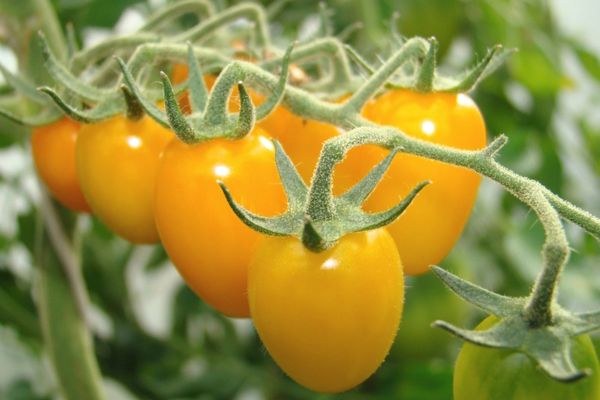 The demand for Golden Rain tomato among gardeners is due to the opportunity to get a real abundance of bright yellow berries of elegant shape and with a mild sweet taste from just a few bushes.
The demand for Golden Rain tomato among gardeners is due to the opportunity to get a real abundance of bright yellow berries of elegant shape and with a mild sweet taste from just a few bushes.
The cultivation of such tomatoes is recommended in unheated greenhouses or in open fields.
Content
Variety Characteristics
The ripening process lasts about 90 - 110 days. The average weight of one ripe tomato is about 15-30 g. The variety belongs to the category of indeterminate (unlimited in growth and fruiting), so that the height of the bushes can reach 1.5 - 1.8 meters, depending on growing conditions. The mid-season type of tomatoes provides the opportunity to harvest the first crop 135 to 140 days after the appearance of the first seedlings. From the moment of transplanting seedlings into the ground to the first ripe fruits, as a rule, about 80 days pass.
The leaves of the bushes are medium in size and bright green in color. The structure of the hands is complex and prone to fruit overload. Subject to the rules of cultivation and care, you can get about 3.5 kg of tomatoes from 1 sq.m. An important feature of this variety is its increased sensitivity to air humidity. Tomato cultivation is best done on sandy or loamy soil types.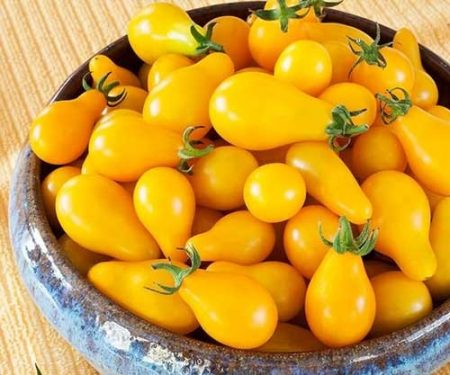
Fruit Description
The shape of the tomatoes is drop-shaped with a characteristic thickening to the bottom. The color of the berries is light yellow. The maximum weight of one fruit is 30 g. The inner flesh is quite fleshy and juicy with a sweet taste. The ripening process of fruits on one brush occurs gradually, while the separation of berries from the stem is very easy. The skin of tomatoes is quite dense, but not coarse, this allows you to use tomatoes, both fresh and as preserves for the winter (tomatoes do not crack during heat treatment). When preparing sauces and pastes, the sweet taste of the dish and unexpectedly bright color are obtained.
Growing recommendations
The abundance of bright tasty tomatoes depends entirely on the correctness of growing and caring for them. If cultivation begins with seeds, then their sowing is recommended in mid-March. The seed container should be in a room with an air temperature of at least 18 degrees and an air humidity of not more than 65%. Lighting seedlings should be carried out daily for 14 to 18 hours. You can plant seedlings in a permanent place in the second decade of May or after the cessation of prolonged night frosts.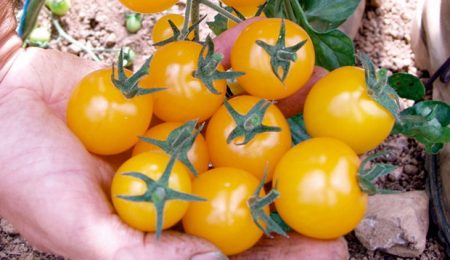
In the process of planting bushes on open ground or in greenhouses, it is necessary to adhere to 60 cm of the distance between the bushes and about 70 cm - between the rows. To strengthen the root system during planting, it is recommended to add double superphosphate or any other mineral complex to the soil. Protection of the soil from drying out can be achieved by covering the root system with straw, grass, or any other dark non-woven material.
If tomatoes are grown in a greenhouse, the level of humidity should not be more than 60%. Overheating of the air is dangerous by sterilizing pollen of flowers, which prevents the appearance of fruits and their further ripening.Soil moisture should be moderate so that the root system can receive the necessary oxygen, so watering the bushes is necessary only after the soil has completely dried.
Features of soil preparation
The soil for planting should be healthy and necessarily fertilized. The best option for choosing a site is the soil on which cabbage, turnips or legumes were previously grown. It is not recommended to plant tomatoes in areas where potatoes or peppers previously grew.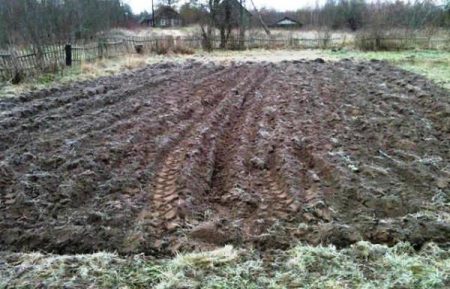
When growing tomatoes in greenhouses, it is recommended to carry out soil sideriding in advance by planting oats, rye or peas, which heal the soil from existing pathogens and microbes.
Pests and diseases
A good balanced taste and high yield of this tomato variety is accompanied by its capriciousness in growing. And to a greater extent this concerns the vulnerability of the bushes to lesions of the black leg and late blight. For successful protection, it is necessary to maintain optimal air humidity (increased humidity is the best environment for the reproduction of microbes), and it is also allowed to use prophylactic solutions based on soda, which are sprayed with bushes 10-15 days after planting or with a two-day infusion of garlic. An alternative is a three percent solution of hydrogen peroxide (200 ml per 10 liters of water).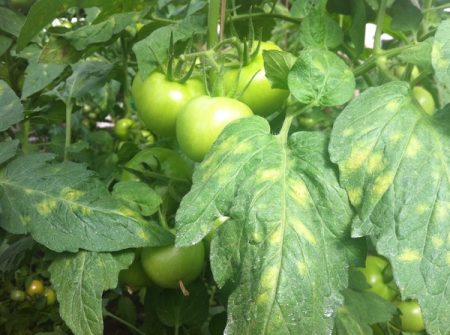
Principles of use
The dense skin does not crack even at high processing temperatures, so tomatoes are easily used for canning. The product itself is very useful in the diet, because it is characterized by the presence of myocin, a substance that helps strengthen the walls of blood vessels. In addition, tomatoes have vitamin A, which helps cleanse the blood and enhances the process of removing harmful substances from the body. Bright yellow tomatoes often help out those who are allergic to red vegetables and fruits.
Reviews
Ekaterina, 42 years old
When growing this variety of tomatoes in a greenhouse, it is extremely important that the room is adequately ventilated and there is no stagnation of water in the soil. Bushes are easier to tolerate short droughts than marshy soils. Especially if there is a risk of late blight or any other fungi. A solution of potassium permanganate, in which the root system is dipped before planting in the ground, can help save the bushes from the black leg. The use of unripened compost as a fertilizer is not allowed, since it is in it that the spores of fungi are most often found. To reduce the acidity of the soil by adding ash to it.




 Low-growing tomatoes, without pinching: 5 of the most delicious varieties
Low-growing tomatoes, without pinching: 5 of the most delicious varieties Why tomato seedlings grow poorly
Why tomato seedlings grow poorly We grow a tomato in a shell
We grow a tomato in a shell Growing tomatoes without watering according to the method of Kazarin
Growing tomatoes without watering according to the method of Kazarin